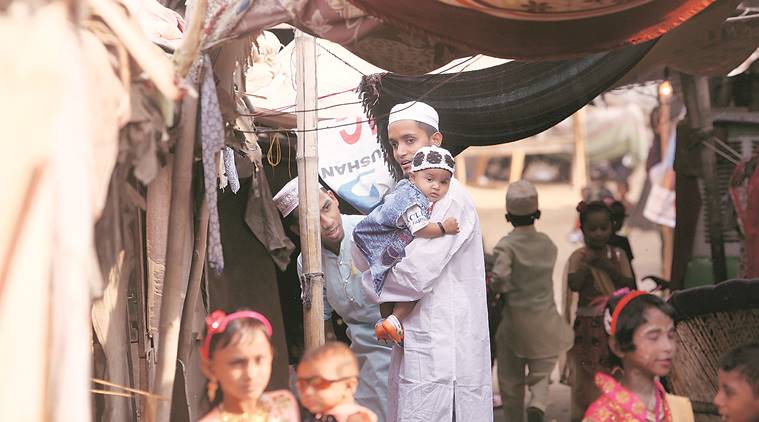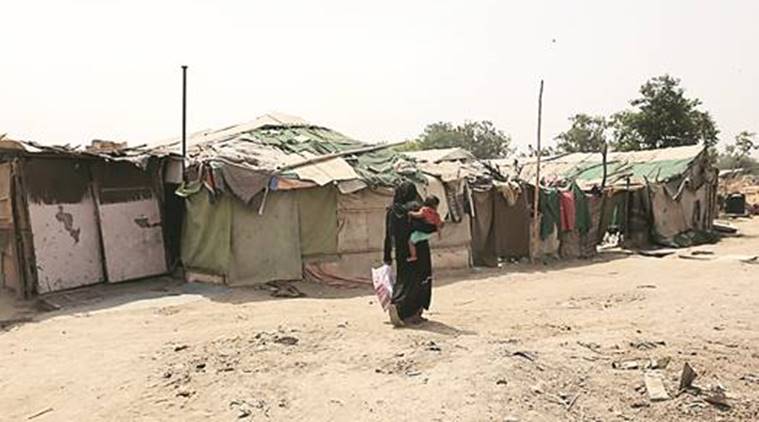
A decade ago, when Fayazul Kalam was a teenager, he fled Myanmar for Bangladesh. By the time he turned 18, he found himself in Jammu, and six months later, at Delhi’s Kalindi Kunj Rohingya camp.
Inside a one-room house with no toilet, Kalam and his wife raised two children. The camp was beginning to feel like home, when a fire gutted 47 homes on April 15 last year.
A year on, the houses haven’t been rebuilt, and 200-plus people have built temporary homes at an adjacent plot, using bits of blankets, mattresses, wooden doors and cardboard pieces — all susceptible to fire.

Salimullah (35), who lives and runs a shop there, said, “The Zakat Foundation of India (ZFI) was to build the homes, but that didn’t happen. We’ve made the structures using materials donated to us last Ramzan.”
ZFI president Dr Syed Zafar Mahmood told The Indian Express, “The Centre released a mandate that banned construction in the area… we don’t know why or when the ban will be lifted.”
The old plot is now covered with flowers and creepers. Next to it at the new camp, the sweltering summer is taking a toll on 66 Rohingya families — electricity connection is temporary and when the “line” is cut, rented fans and coolers become useless.
“Children are the worst hit… they get dehydration, diarrhoea and rashes. In the last month, I had to take my two children, aged three and five, to the dispensary thrice… every time at the cost of work,” said Kalam (26), who drives a rented e-rickshaw.
For Salimullah, the fire meant double jeopardy, as his kirana store on the main road was also gutted. “I set it up again, but since this is a low-lying area, people have stopped coming here because it’s inconvenient… they hesitate,” he said.
Eid festivities, too, were low-key at the camp. “It would have been a celebration if we were back in the old camp… Most of us have heatstroke now,” Salimullah said. Once summer ends, rain will bring another problem — flooding. “The camp is low-lying and even with a little rain, water can enter homes and bring new problems… it happened last time too,” said Mohd Shakir, a resident.
A few kilometres away at Shaheen Bagh are clusters of displaced pockets — from a group of families from UP’s Ayodhya to 85 Rohingya families from Myanmar. The housing is similar to the camp at Kalindi Kunj, with five hand-pumps for 300-plus people.
Mohd. Ayas (30), recovering from a bout of typhoid, said he had to rush his 10-month-old son to a dispensary nearby at least four times in the last month.
“He vomits and has an upset stomach. The heat has caused blisters on his arms, doctors have asked me to give him ORS,” said Ayas, a daily wager, who has missed work for over two weeks.
Last week, when temperature touched 47 degrees Celsius, Ayas took his two children to the Kalindi Kunj Metro station.
“We just sat on the steps — it was cooler than being here and the baby stopped crying,” he said.
The hand-pump under a tree’s shade remains busy all day. Toddlers sit in a puddle there, while their mothers wash utensils and clothes.
“It’s the only way to handle the heat, even though the water is dirty and smells. Younger children end up drinking it and then fall sick. Drinking water is expensive if you are a daily wage earner… it costs Rs 15-20 for a water can. It’s so hot that a family of five needs two such bottles daily… some days, we let them drink the hand-pump water,” said 30-year-old Rashida Begum.